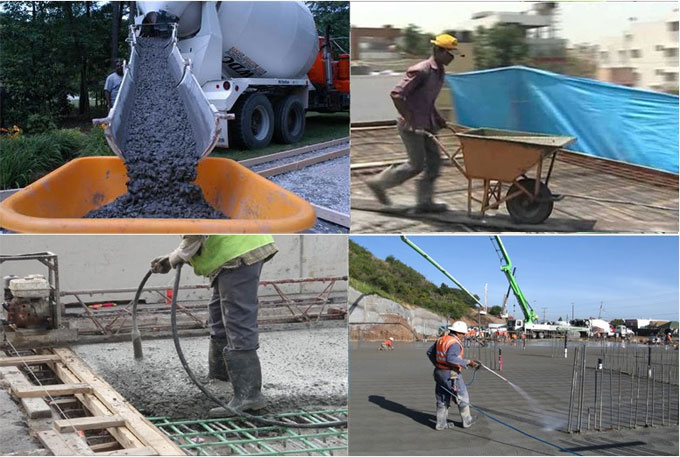
Some common types of concrete curing methods
To form concrete, cement, coarse aggregates, fine aggregates and water are mixed in specific ratios. Given below, detailed stages involved for manufacturing of concrete:
1. Batching: It stands for the method of exact measurement of concrete materials to maintain consistency of proportions and aggregate grading based on mix design proportions. Batching is done with volume or weight.
Batching by Volume: It is normally applied for general construction works and it is executed with wooden or steel boxes. In volume batching, bulking effect of sand should be taken into consideration.
Batching by Weight: Batching by weight is applied for vital projects with the help of batching plants. Weight batching is more authentic as compared to volume batching.
2. Mixing: Once batching is completed all the materials of concrete are carefully mixed unless the concrete attains consistent color and necessary uniformity. Mixing of concrete is performed manually or mechanically.
Manual Mixing: Manual mixing is suitable for small construction activities. In manual mixing, concrete remains less productive and needs more cement as compared to machine mixing to acquire the equivalent strength.
Machine Mixing: Machine mixing is ideal for general construction works. Under this process, the mixing is done by batch mixers or continuous mixers. For normal works 10/7 or ? cubic yard capacity mixers should be utilized. 10/7 signifies 10 cubic feet of dry material that produces 7 cubic feet of wet concrete. One cement bag capacity mixers are mostly recommended. Mixing time should not remain under 90 seconds.
3. Transportation: Transportation means the method of dispatching the concrete from the location of mixing to the job. Transportation varies from manual or mechanical.
Manual Transportation: Manual transportation is perfect for small construction activities or when the construction site is adjacent to the location of mixing.
Mechanical Transportation: Mechanical transportation via pumps or lifts is accepted for large construction activities or when there is long distance between the construction and the location of mixing. The time of transportation should be less to retain the concrete plastic prior to compaction.
4. Compaction: The method of solidifying the concrete after placement of concrete is called as compaction of concrete. Properly check that there should no air bubbles or voids in the concrete during compaction as the strength of concrete is significantly reduced. 5% air voids in concrete will decrease its strength up to 30%. Compaction is done with manual or mechanical means.
Manual Compaction: Manual compaction via tempering and rodding is implemented for small and less important concrete works.
Mechanical Compaction: Mechanical compaction via vibrators is performed for large, vital and general concrete works. Vibrators are arranged externally or internally depending on the necessary level of compaction.
5. Curing: Curing stand for the method of retaining the concrete moist or wet for specific time period once placing and compaction is finished to accomplish the hydration process and attain the required strength. Concrete formed with ordinary and sulphate resistant cements should be cured for minimum 8 days, whereas the concrete formed with low-heat cement should be cured for minimum 14 days.
Most common processes of curing :
By wet Jute Bags: Under this process, wet jute bags are utilized to wrap the concrete surface to be cured and the bags are sprayed with water from time to time to keep them wet. This method goes on unless the curing period is completed. This method is best suited for small horizontal and vertical concrete surfaces.
By Spraying Water: Under this process, water is sprayed on the concrete surfaces constantly unless the curing stage is completed.
By Soaking in Water Pond: It is suitable for pre-cast concrete members. Under this method, the precast members are soaked in water pond unless the curing period is finished.
Steam Curing: This process is effective for pre-cast concrete members. Steam under pressure is sprayed over the concrete structure. Steam curing expedites the strengthening of concrete and the time period of curing is significantly decreased.
Inclusion of Chemicals: Under this process, specific construction chemicals are provided to decrease the rate of evaporation of water from the concrete. No standard curing process is necessary in case of applying the chemicals.


